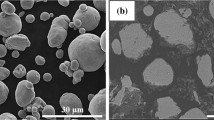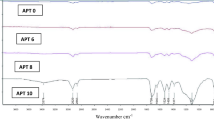Abstract
Because of its merits, acrylic resin was chosen to improve the mechanical, conductive and hydrophobic properties. Carbon fiber powders (CF), carbon nanotubes (MWCNT), and nano-TiO2 were incorporated into the acrylic resin to prepare the corona-proof conductive composite coatings. The incorporation of CF and MWCNT may improve the conductivity and mechanical strength of the coatings. However, the addition of nano-TiO2 may increase the hydrophobicity of the coatings. Thus, the effects of different additives on the mechanical properties, conductivity, hydrophobicity and heat resistance of the conductive film were studied. The experimental results show that the incorporation of carbon fiber powders and multi walled carbon nanotubes can significantly improve both the conductivity and mechanical properties of the conductive coatings, and the addition of nano titanium dioxide can improve the hydrophobicity of the conductive film.
Similar content being viewed by others
References
Zhang M, Wang K, Tong Y. Research on Electric Field Suppression of Tubular Terminal Busbar for Shunt Reactor in 1000 kV UHV Substation[J]. Insulators & Surge Arresters, 2018, 000(003): 195–201
Dong M, Ma A, Ren M, et al. Positioning and Imaging Detection of Corona Discharge in Air with Double Helix Acoustic Sensors Array[J]. Energies, 2017, 10(12): 1–15
Taylor ER, Chartier VL, Rice DN. Audible Noise and Visual Corona from HV and EHV Transmission Lines and Substation Conductors — Laboratory Tests[J]. IEEE Transactions on Power Apparatus & Systems, 1968, PAS-88(5): 666–679
Lan BH, Meng C. Treatment Measures of Corona Noise in Substation[J]. Shanxi Electric Power, 2012, 176: 44–47
Zhang GZ, Zhang XQ, Zhang GD, et al. Differentiated Design of Corona Noise Abatement in 500 kV Substation[J]. Advanced Materials Research, 2012, 518–523: 3 761–3 767
Korzhov AV, Okrainskaya IS, Sidorov AI, et al. A Study of Electromagnetic Radiation of Corona Discharge Near 500-kV Electric Installations[J]. Power Technology & Engineering, 2004, 38(1): 57–60
Cauwelaert RV, Hanssens I, Herreman W, et al. Synthesis of Silicone-Acrylic Resins and Their Applications to Superweatherable Coatings[J]. Journal of Applied Polymer Science, 2010, 81(7): 1 614–1 623
Carretti E, Dei L. Physicochemical Characterization of Acrylic Polymeric Resins Coating Porous Materials of Artistic Interest[J]. Progress in Organic Coatings, 2004, 49(3): 282–289
Park HS, Kim SR, Park HJ, et al. Preparation and Characterization of weather Resistant Silicone/Acrylic Resin Coatings[J]. Journal of Coatings Technology, 2003, 75(936): 55–64
Pini T, Briatico-Vangosa F, Frassine R, et al. Matrix Toughness Transfer and Fiber Bridging Laws in Acrylic Resin based CF Composites[J]. Engineering Fracture Mechanics, 2018, 1203: 115–125
Yazdanie N, Mahood M. Carbon Fiber Acrylic Resin Composite: An Investigation of Transverse Strength[J]. Journal of Prosthetic Dentistry, 1985, 54(4): 543–547
Guo X, Ge S, Wang J, et al. Waterborne Acrylic Resin Modified with Glycidyl Methacrylate (GMA): Formula Optimization and Property Analysis[J]. Polymer, 2018
Liu X, Yang C, Wang X, et al. Effect of Nanometer-sized TiO2 on Reactivity and Thermal Properties of Modified BMI Resins[J]. Acta Materiae Compositae Sinica, 2001, 18(1):12–15(in Chinese)
Author information
Authors and Affiliations
Corresponding authors
Additional information
Funded by the State Grid Shaanxi Electric Power Company (5226KY17001B), the Natural Science Foundation of Hubei Province (2019CFB787), and the State Key Laboratory of New Textile Materials and Advanced Processing Technologies (FZ2020012)
Rights and permissions
About this article
Cite this article
Wu, J., Han, W., Zhao, Y. et al. Preparation and Performance of Corona-proof Conductive Composite Coatings. J. Wuhan Univ. Technol.-Mat. Sci. Edit. 36, 505–509 (2021). https://doi.org/10.1007/s11595-021-2437-3
Received:
Accepted:
Published:
Issue Date:
DOI: https://doi.org/10.1007/s11595-021-2437-3




